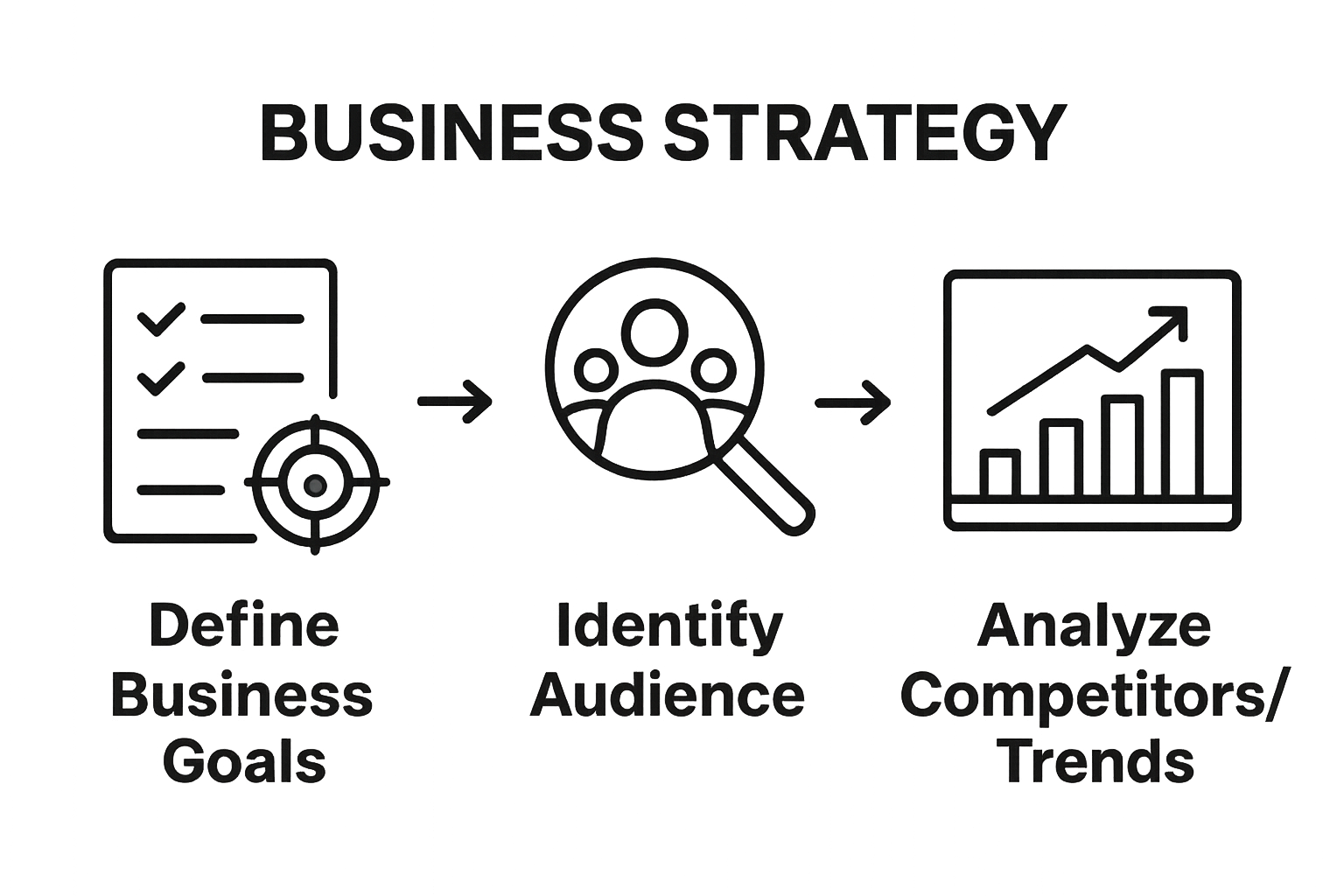7 Steps to Build a Marketing Strategy Template That Works

Learn how to create a marketing plan step-by-step to effectively boost your business with actionable strategies and measurable results.

Building a powerful marketing plan can feel overwhelming and chaotic. Most people jump straight into flashy ads or social media trends, hoping for quick results. But the research shows that companies with well-defined marketing plans are 313 percent more likely to report success than those that wing it. The surprising truth is that you do not need a big budget or a marketing degree to get results. You just need the right step-by-step process to turn scattered ideas into a strategy that actually works.
Creating a powerful marketing plan begins with crystal clear business goals and objectives. This foundational step transforms vague aspirations into actionable strategies that drive meaningful growth. Without well-defined objectives, your marketing efforts become scattered and ineffective.
Starting your marketing plan requires deep self-reflection about what you truly want to achieve. Think beyond surface level metrics like “make more money” and drill into specific, meaningful outcomes. Your goals should connect directly to your business vision and provide a roadmap for strategic decision making.
Crafting Meaningful Business Objectives
Begin by asking yourself critical questions: What does success look like for your business in the next 12 months? Are you aiming to increase revenue, expand market share, launch new products, or establish brand recognition? Each objective needs to be precise and measurable.
According to research from the U.S. Small Business Administration, your objectives should follow the SMART framework:
For example, instead of saying “I want to grow my business,” a SMART objective might be “Increase monthly recurring revenue by 25% within the next six months by acquiring 10 new clients in my target market.”
Remember that your marketing objectives should directly support these broader business goals. If your primary objective is expanding market reach, your marketing plan will focus on strategies that increase visibility, attract new audiences, and build brand awareness. By establishing clear, interconnected goals, you create a strategic framework that guides every marketing decision and resource allocation.
Below is a summary table providing an overview of all steps required to create an effective marketing plan, including the main focus of each stage and the key outcome you should achieve.
StepMain FocusKey Outcome1Define business goalsSpecific, measurable objectives established2Identify target audienceIn-depth ideal customer profile created3Analyze competitorsClear understanding of market landscape4Develop value propositionCompelling UVP that sets you apart5Create tactical strategyActionable marketing roadmap6Monitor and adjustOngoing improvement using performance data
Understanding your target audience is like having a secret map to business success. This critical step transforms generic marketing efforts into precise, resonant strategies that speak directly to the people most likely to become your customers. Without a clear picture of who you’re serving, your marketing becomes a shot in the dark.
Target audience identification goes far beyond basic demographics. You need to develop a 360-degree understanding of your ideal customer—their hopes, challenges, behaviors, and motivations. Think of this process as creating a detailed character profile that will guide every marketing decision you make.
Start by conducting deep research into your potential customers. Map out their characteristics through a combination of existing data, customer interviews, and market analysis. Who are they? What problems do they face that your business can solve? What are their purchasing habits, communication preferences, and lifestyle choices?
According to research from Johns Hopkins University, effective audience segmentation involves exploring multiple dimensions:
Create a detailed customer avatar that represents your ideal client. Give them a name, backstory, and specific characteristics. This isn’t just an exercise—it’s a strategic tool that helps you understand how to communicate, what solutions to offer, and where to find your audience.
Don’t just guess or assume. Validate your audience understanding through direct conversations, surveys, and market research. Talk to existing customers, analyze competitor audiences, and be willing to refine your understanding continuously. The most successful businesses treat audience identification as an ongoing process of learning and adaptation.
Competitive analysis transforms your marketing strategy from guesswork into a precise roadmap. This step helps you understand the landscape in which your business operates, revealing opportunities and potential challenges that can make or break your marketing efforts.
Think of competitive analysis as strategic reconnaissance. You are not just looking at what other businesses are doing, but understanding the deeper patterns, strategies, and whitespace that can give you a significant advantage. This isn’t about copying competitors, but identifying unique ways to differentiate and excel.
Understanding the Competitive Landscape
Begin by creating a comprehensive list of direct and indirect competitors. Direct competitors offer similar products or services, while indirect competitors might solve the same customer problem through different approaches. Research each competitor thoroughly, examining their marketing strategies, pricing models, brand positioning, and customer engagement techniques.
According to research from the U.S. Small Business Administration, your competitive analysis should explore several key dimensions:
Use tools like social media monitoring, customer reviews, industry reports, and competitor websites to gather insights. Pay attention to not just what competitors say about themselves, but how customers and the market respond to them.
To help clarify the differences between direct and indirect competitors, the table below compares these two types of competition along with the typical areas you should analyze for each.
Competitor TypeDescriptionWhat to AnalyzeDirectOffers similar products/servicesMarketing, pricing, customer feedbackIndirectSolves the same problem with alternativesAlternative solutions, market trends
Beyond individual competitors, track broader market trends. What technological shifts are emerging? How are customer preferences changing? What economic or social factors might impact your industry? By understanding these macro trends, you can anticipate changes and position your business proactively.
Remember that competitive analysis is not a one-time task.

Markets evolve rapidly, and your understanding must be dynamic. Set up regular review periods to reassess the competitive landscape and adjust your strategies accordingly. Your goal is to find your unique competitive advantage—the special something that sets you apart and makes your business irresistible to your target audience.

Your unique value proposition (UVP) is the strategic heart of your marketing plan—the compelling reason why customers should choose your business over every other option. This isn’t just a catchy slogan, but a clear, concise statement that communicates the specific benefits and unique advantages your business delivers.
Think of your value proposition as a promise. It answers the critical customer question: “Why should I care about your business?” A powerful UVP cuts through the noise, speaks directly to your target audience’s deepest needs, and instantly differentiates you from competitors.
Crafting a Resonant Value Proposition
To develop a standout UVP, you must first deeply understand the problems your target audience experiences. What specific challenges are they facing? What solutions have they tried that didn’t work? Your value proposition needs to demonstrate that you not only understand their pain points but have a unique approach to solving them.
According to research from Cornell University’s eCornell, an effective value proposition combines several critical elements:
Start by listing your business’s most distinctive strengths. What can you do that competitors cannot? Perhaps you have a proprietary process, specialized expertise, or an innovative approach that sets you apart. Your UVP should highlight these unique qualities in language that resonates with your target audience.
Avoid generic statements that could apply to anyone. Instead, be specific and personal. For example, instead of saying “We provide great service,” you might say “We help overwhelmed entrepreneurs reclaim 10 hours per week through our streamlined productivity system.” This approach transforms a bland promise into a tangible, compelling offer.
Test your value proposition by showing it to potential customers and gathering feedback. A truly powerful UVP will spark immediate interest and curiosity. It should be clear, concise, and communicate value within seconds.
Your tactical marketing strategy transforms your big-picture goals into concrete, actionable steps. This is where strategy meets execution, turning your vision into a roadmap that guides every marketing decision. Think of it as the operational blueprint that will drive your business forward.
A robust tactical strategy requires synthesizing everything you’ve learned about your business, target audience, and competitive landscape. You’re now crafting a precise approach that will connect your unique value proposition with the right customers through the most effective channels.
Building Your Strategic Marketing Framework
Start by selecting marketing channels that align perfectly with your target audience’s behaviors and preferences. Not all channels are created equal—where does your ideal customer spend their time? Are they scrolling through Instagram, searching on Google, or networking on LinkedIn? Your channel selection should be surgical and intentional.
According to research from OpenStax’s Business Introduction, effective marketing strategies combine four key elements:
Consider creating a comprehensive marketing strategy that breaks down specific tactics for each channel. For digital marketing, this might include content creation schedules, ad spend allocations, email campaign timelines, and social media engagement plans. For traditional marketing, outline print materials, networking events, and potential partnerships.
Remember that your tactical strategy should remain flexible. Build in regular review points—perhaps quarterly—where you can assess performance, adjust tactics, and reallocate resources based on what’s working. The most successful marketing plans are living documents that evolve with your business and market conditions.
Finally, establish clear key performance indicators (KPIs) for each tactic. How will you measure success? Whether it’s lead generation, conversion rates, or engagement metrics, having concrete benchmarks will help you continually refine and improve your marketing approach.
Performance monitoring is the heartbeat of a living, breathing marketing strategy. This final step transforms your marketing plan from a static document into a dynamic, responsive system that continuously learns and improves. Think of it as the mission control center for your marketing efforts, where data becomes your most powerful decision-making tool.
Successful performance monitoring requires more than just collecting numbers. You need to develop a nuanced understanding of what those metrics truly mean for your business. Are you just tracking vanity metrics, or are you uncovering real insights that drive meaningful growth?
Establishing Your Performance Tracking System
Begin by setting up robust tracking mechanisms for each marketing channel and tactic. This means implementing tools that can provide comprehensive, real-time data about your marketing performance. Google Analytics, social media insights, email marketing platforms, and customer relationship management (CRM) systems become your strategic allies in this process.
Choose key performance indicators (KPIs) that directly align with your original business objectives. These might include:
Schedule regular performance review sessions—monthly or quarterly—where you critically examine these metrics. Look beyond surface-level numbers to understand the story behind the data. What strategies are working? Which tactics need refinement? Where are the unexpected opportunities or potential bottlenecks?
Remember that flexibility is key. A great marketing plan is not set in stone but a living document that evolves with your business and market conditions. Be prepared to pivot quickly. If a particular channel isn’t delivering results, don’t hesitate to reallocate resources or experiment with new approaches.
Ultimately, performance monitoring is about continuous learning and adaptation. Treat each data point as a valuable piece of intelligence that can help you make more informed decisions. Your marketing plan should be a dynamic tool that grows and improves alongside your business.
If you are tired of marketing plans that never seem to drive real business growth, you are not alone. Many entrepreneurs and founders struggle to connect broad goals and tactical execution, leaving their marketing efforts unfocused and results inconsistent. The article highlighted how unclear objectives, lack of audience insight, and scattered strategy are often the barriers standing in your way. But it does not have to stay that way.

Reasonate Studio transforms chaos into clarity. Our proprietary Aligned Impact Model™ guides you through each stage—from defining measurable goals to building a tactical blueprint that actually works for your business. We help entrepreneurs identify their unique value, truly understand their audience, and develop systems that support sustainable growth. Ready to bridge the gap between your vision and measurable outcomes? Visit https://reasonatestudio.com today to discover how our strategic approach can align your marketing with your business success. Book your free clarity call now and start building a marketing plan that finally resonates.
Creating a marketing plan starts with defining your business goals and objectives. This involves identifying what success looks like for your business, setting specific, measurable, achievable, relevant, and time-bound (SMART) objectives that are aligned with your broader business strategy.
To identify your target audience, conduct thorough research that includes analyzing demographics, psychographics, and behavioral patterns. Creating detailed customer avatars can help you understand who your ideal clients are and how to effectively communicate with them.
A Unique Value Proposition (UVP) is a clear statement that describes the unique benefits your product or service offers. It is crucial because it differentiates your business from competitors and communicates why customers should choose you over others.
Measure the success of your marketing efforts by establishing key performance indicators (KPIs) that align with your business objectives, such as conversion rates, customer acquisition costs, and return on marketing investment. Regularly review these metrics to analyze performance and adjust your strategies accordingly.